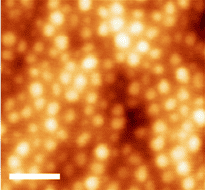
AFM image of typical networked particle film self-assembled on SiO2 substrate (scale bar equals 100 nm)
Molecular junctions, formed by attaching molecules to metal electrodes, can reduce the size of electronic devices and potentially perform functions similar to conventional semiconductor electronics.
These molecular devices may also provide an alternative and/or to complement the existing technology with novel functionality.
Previous work on nanoparticle-molecular systems, consisting of either bulk films with very large numbers of molecules or nanoparticles with single/few molecules, gave inspiration for the recently published article in Physica Status Solidi B. The scientists have investigated the electrical properties of self-assembled gold nanoparticle-molecular networks in the intermediate regime between the bulk and single molecules, and examined the effect of molecule-nanoparticle ratio on electronic transport through these nanoscale molecular circuits.
By adjusting the gold nanoparticle to molecule ratio and/or type of molecule in the network, a directed self-assembly process to effect different circuit configurations results in tunable electrical conductance over several orders of magnitude.
This inexpensive solution‑based technique shows promise for designing molecular electronic circuits based on different network morphologies. Imaging of the colloidal gold networks via atomic force microscopy indicates that the number of molecules is important for achieving good network packing in order to form well-connected molecular electronic circuits.
These results demonstrate a directed self-assembly as a potential avenue for the creation of molecular integrated circuits and may provide a way for the design of novel molecular electronic networks for logic or memory applications.
The text was kindly provided by Chris Papadopoulos and edited by Ekaterina Perets.

















